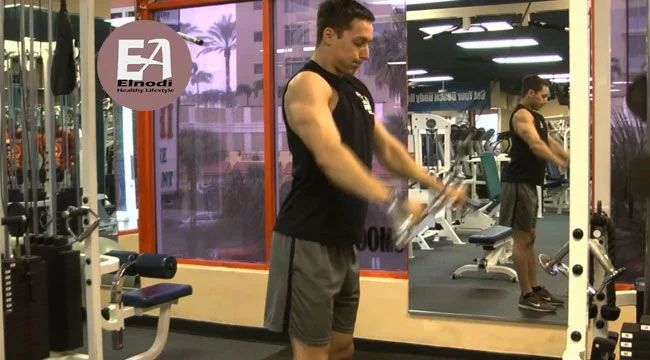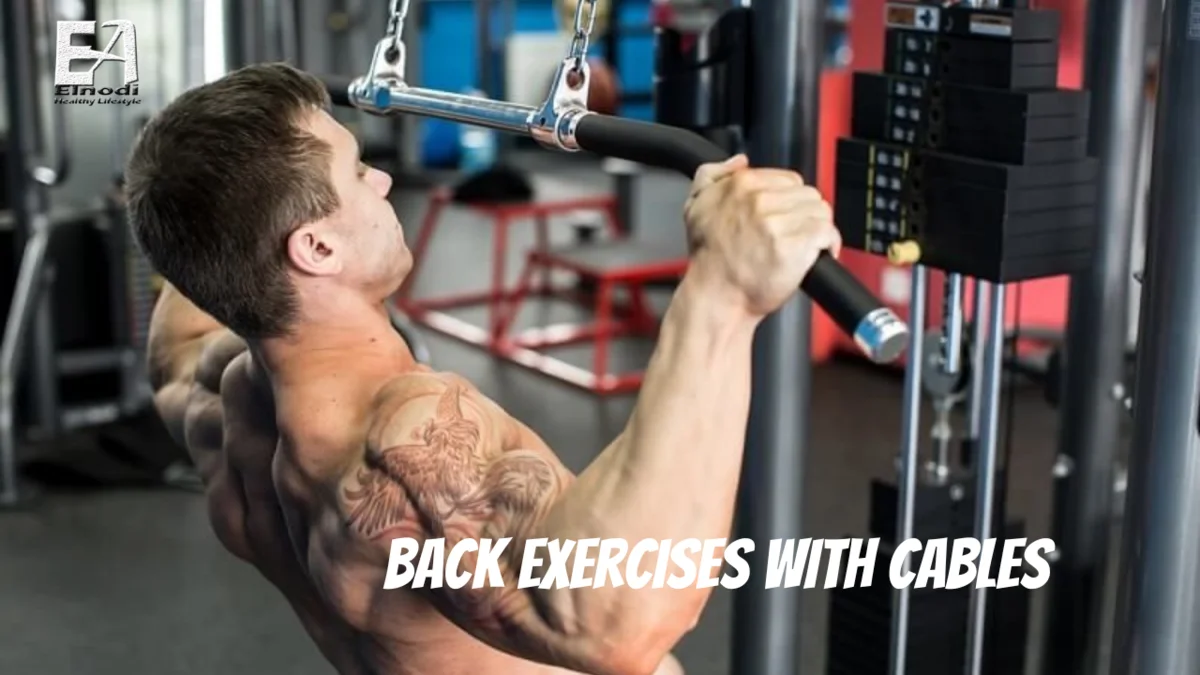These back exercises with cables will help you develop a V-Tapered physique.
When it comes to exercising, most people think of cardio and strength training. While effective, these two categories are not the only options. You can also focus on your back with cable exercises. In this article, we will give you the best reasons why you should try them and what kinds of back exercises with cables they are.
benefits of back exercises with cables
- Variety: You may execute a variety of cable exercises, which helps to keep your workouts fresh and prevents monotony.
- Intensity: By altering the weight or resistance, cable exercises can be made more or less severe. As a result, they are an excellent choice for both novice and expert lifters.
- Safety: Cable exercises are generally safe for most people, as they put less stress on your joints than free-weight exercises.
- Isolation: Cable workouts allow you to isolate specific muscle groups, allowing you to address your weaknesses while also improving your overall strength and conditioning.
- Control: Cable workouts provide you with more control over the movement, allowing you to enhance your technique and avoid injuries.
- Progression: Cable exercises can be easily progressed by increasing the weight or resistance, or by adding more sets and reps. This makes them a great option for long-term muscle growth and development.
- Improved posture: Strong back muscles can help to improve your posture by supporting your spine and shoulders.
- Reduced back pain: Back pain is a common problem, but it can often be relieved by strengthening your back muscles.
- Improved athletic performance: Strong back muscles can help you perform better in a range of sports, including swimming, jogging, and basketball.
- Increased confidence: A strong and powerful back can enhance your confidence and make you feel better about yourself.
muscles worked back exercises with cables

Latissimus dorsi (lats): The lats are the major muscles on your back’s sides. They are in charge of drawing your arms down and back. Lat pulldowns, seated cable rows, and wide-grip cable rows are all excellent lat exercises.
Rhomboids: The rhomboids are the muscles located in the center of your back. They are in charge of bringing your shoulder blades together. Face pulls and bent-over cable rows are also excellent workouts for targeting the rhomboids.
Trapezius: The trapezius is the large muscle that runs along the back of your neck and shoulders. It is responsible for raising your shoulders and shrugging your shoulders. Cable shrugs and face pulls are both great exercises for targeting the trapezius.
Biceps: The biceps muscles are located in the front of your upper arms. They are in charge of bending your elbows. While cable back workouts do not primarily work the biceps, they can be used to target them to some extent. For example, you can work your biceps more effectively by using a close-grip attachment on a lat pulldown machine.
Back workouts with cables can also target a range of minor muscles in your back, including the serratus anterior, levator scapulae, and infraspinatus.
Best back exercises with cables For Wider And Strong Back
1. Wide-Grip Lat Pulldown
What distinguishes this as the best? It’s as close to a Pull-Up as you can get, which means it’s the perfect exercise for training all of the muscles involved in Pull-Ups. Pull-ups are a very typical metric for measuring fitness and functional strength, therefore they should be included in your weekly training sessions.
If you can’t perform many Pull-Ups (and, let’s be honest, many of us still struggle to finish a full set), Wide-Grip Lat Pulldowns provide the same workout, but instead of pushing your body weight up toward the bar, you pull the bar down toward your body.
The Wide Grip targets your lats while also working your posterior deltoids, traps, and rhomboids. It also promotes greater upper back width. This is the “opener,” the first exercise you undertake with the most weight you can handle. More time spent on this exercise will assist you in developing the strength required to improve your Pull-Up performance.
2. Close-Grip Lat Pulldown

Moving your hands closer together for the Close-Grip Lat Pulldown alters the angle of the exercise, shifting the emphasis to the upper lats and improving overall upper back strength. It’s a little more difficult on your wrists, but it gives your elbows more range of motion.
For the Close Grip, your hands should be narrower than shoulder-width apart, but if the angle is too painful on your wrists (for those recovering from wrist strains or sprains), you can slide them slightly outward to shoulder width.
Because you’ll be dragging the weight downward across the front (front) plane of your body, your core muscles will have to work harder. However, going through the entire motion of pulling the bar down to your chest and slowly raising it back up to the “resting” position can put a lot of strain on your upper back muscles and help you gain strength.
3. Reverse-Grip Lat Pulldown
Reversing your grasp transforms it from a “Pull-Up Grip” to a “Chin-Up” grip. This grip places a higher emphasis on the biceps, which is beneficial if you want to improve arm and shoulder strength as well as upper back strength. If you want to focus on your upper back, though, frequent Wide Grip Lat Pulldowns are the way to go.
The focus moves to your lower lats, and there is higher core activation (akin to close grip lat pulldowns). You’ll have to make a conscious effort to maintain your shoulders back and down and to prevent pulling the bar down with your momentum. The better the movement, the more isolated and controlled it is!
4. Seated Cable Rows
Seated Cable Rows are ideal for anyone looking to build strength for rowing—rowing machines, rowing boats, kayaks, canoes, and so on. It’s a “front and back pull” rather than an “up and down pull,” with the strain coming from immediately in front of you rather than overhead.
Seated Cable Rows target your upper back, along with your mid-back and traps. Using different bars and handles can change the focus of the exercise—i.e., a wide-grip bar can build breadth, while a close-grip Double-D handle will build strength along the spinal column.
This exercise involves your lower back more, which is good if you’re attempting to build core strength but bad if you’re recuperating from a lower back injury. To reduce lower back pain, keep your upper body immobile and pull the wire using only your arms, shoulders, and back muscles on each repetition.
5. Full Extension Seated Cable Rows
This is an excellent variation of the Seated Cable Row, one that places even more focus on the mid-back, particularly the lower lats, and rhomboids.
Instead of isolating your torso, you allow your body to lean forward slightly as you return to the “resting” position, allowing your shoulders to slip forward to full extension. This forces your back to engage earlier in the movement and focuses the initial movement on your rhomboids for better targeting.
However, if you have lower back issues or are recovering from an injury in your shoulders, it’s better to avoid this exercise due to the higher range of motion—which gives more chances for injury.
6. Straight-Arm Pulldown

This is an interesting isolation exercise that helps you to develop better upper back strength across a broader range of motion than most other pull exercises. Instead of recruiting the arms or shoulders, it’s entirely focused on your lats.
The Straight-Arm Pulldown is performed with your arms fully extended, your waist slightly forward, and your upper back muscles doing all of the work of pushing the weight down across the front of your body. Start with light weights to focus on the specific, controlled movement, then gradually work your way up to bigger weights until you’re comfortable with the isolation.
7. One-Arm Seated Cable Rows
Any “one-arm” exercise enhances core muscle engagement (obliques, abs, and spinal erectors) to improve core strength and stability. This exercise isn’t recommended for people healing from lower back problems, but it can help you build lower back and core strength to lessen your chance of damage in the future.
The form of the One-Arm Seated Cable Row is the same as the Seated Cable Row, except you’re grasping a D-handle in one hand instead of a wide-grip bar in two. Twist your torso slightly as you draw the weight to your abdomen to increase the core-focused aspect of the workout. This trunk rotation will work the obliques, abs, and back, strengthening these important stabilizer muscles.
The One-Arm Seated Cable Row allows you to determine which of your arms is stronger (it’s not usually the dominant side), making it easier to prioritize the weaker arm in your training.
8. Kneeling Cable Crossover Lat Pulldown
The cable crossover lat pulldown while kneeling is a good variant for training your back for width. In contrast to the standard lat pulldown, you will need the cable crossover station.
What’s so special about this exercise? The cable crossover machine allows you to perform the lat pulldown with a wider grip, focusing more on the upper lats and teres major. Having strong and well-developed teres major can significantly influence the width of your back.
Furthermore, both hands move separately, allowing you to practice muscle symmetry. The freedom of movement provided by two distinct pulleys strengthens the mind-muscle connection and allows you to effectively compress and contract those lats.
9. Incline Cable Row
When you have lower back discomfort, most rowing variations feel quite difficult.
The incline cable row allows you to work on the horizontal pulls without taxing the lower back.
By removing the role of core stabilization, you can devote your complete attention to back engagement, which benefits the mind-muscle link.
10. Cable Shrug
Shrugs help you develop massive traps. Well-developed traps not only build a cobra back but also plays a crucial role in your performance during deadlifts, squats, and Olympic lifts.
When there isn’t enough free weight to complete the shrugs, cables are frequently the greatest option. When it comes to mind-muscle connections, wire shrugs are marginally superior.
Cable shrugs can be done with single or double cables. Because you are pulling the weight up and toward the body at the same time, double wires improve the quality of trap contraction.
back exercises with cables vs free weights
Back exercises with cables and free weights can both be beneficial for developing a strong and muscular back. However, there are some important distinctions between the two types of exercises that may make one a better fit for you than the other.
Cable exercises
pros:
Cable exercises have a wider range of motion than free-weight exercises. You may execute a variety of cable exercises, which helps to keep your workouts fresh and prevents monotony.
Cable exercises can be made more or less intense by adjusting the weight or resistance. This makes them a great option for both beginners and experienced lifters.
Cable exercises are generally considered safe for the majority of individuals because they place less strain on your joints than free-weight exercises.
Cable workouts allow you to isolate specific muscle groups, allowing you to address your weaknesses while also improving your overall strength and conditioning.
cons:
Cable machines can be expensive to purchase or rent.
Cable machines can take up a lot of space in a gym or home workout area.
Cable machines can be more difficult to use than free weights, therefore thorough coaching from a skilled personal trainer or fitness teacher is essential.
Free weight exercises
pros:
Cable exercises are less versatile than free-weight exercises. Free weights can be used for a greater range of exercises, including squats, deadlifts, bench presses, and overhead presses.
Free weight exercises can help to improve your balance and coordination.
Free weight workouts can aid in the development of functional strength, or the capacity to use your muscles in everyday activities.
cons:
Free weight exercises can be more dangerous than cable exercises, as there is a greater risk of injury if you do not use the proper form.
Free weight exercises can be more challenging for beginners, as they require more stabilization from your core and other muscles.
Finally, the optimum sort of back exercise for you will be determined by your specific needs and goals. If you want to create a strong and muscular back in a safe and effective manner, both cable workouts and free weight exercises might be beneficial. If you are new to strength training or are concerned about your safety, it is advisable, to begin with cable workouts. As you gain strength and expertise, you can progress to free-weight exercises.
Cable Back Workout Samples
Warm-up:
5 minutes of light cardio, such as jogging or jumping jacks.
10-15 reps of each of the following exercises:
Bodyweight rows
Plank
5 reps of each of the following exercises:
Lat pulldowns
Seated cable rows
Workout:
- Lat pulldowns: 3 sets of 8-12 reps
- Seated cable rows: 3 sets of 8-12 reps
- Wide-grip cable rows: 3 sets of 8-12 reps
- Straight-arm pulldowns: 3 sets of 10-15 reps
- Face pulls: 3 sets of 10-15 reps
Cool-down:
- 5 minutes of light cardio.
- Stretching: Hold each stretch for 30 seconds.
- This is just a sample workout, so you can adjust it to fit your own needs and goals. You can also add or remove exercises as you see fit. It is important to listen to your body and take breaks when you need them.
Here are some other tips for getting the most out of your cable back workout:
- Use a weight that is challenging but not too heavy. You should be able to maintain good form throughout the entire range of motion.
- Focus on pulling the weight with your back muscles, not your arms. This will help you to target the muscles in your back more effectively and avoid injuries.
- Keep your core engaged throughout the exercise. This will help to stabilize your spine and prevent injuries.
- Control the weight on the way up and down. Don’t let the weight jerk you around.
- Take a break between sets if needed. Don’t try to do too much too soon.
- Listen to your body. If you feel pain, stop the exercise and consult with a doctor or physical therapist.
Summary
These fifteen incredible exercises will take your upper back workout to a whole new level, delivering substantial results thanks to the constant strain that makes cable machines so effective. They’re not a replacement for Pull-Ups or free weight exercises (such as Rows, Bent-Over Rows, Dumbbell Rows, and so many others), but they can be used in your routine as needed to maximize results.
By introducing the cable machine into your workout, you can improve physical strength by utilizing both the concentric and eccentric parts of the exercises, resulting in faster strength and size improvements. You’ll enjoy the burn as you practice the activities described above!





